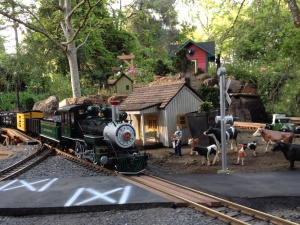Kits and Scratch Built Structures
HOW WE PUT BUILDINGS ON OUR GARDEN RAILROAD LAYOUTS
Putting buildings on your garden railway can be as simple as purchasing them ready-made, buying kits to assemble, or scratch-building them. Most layouts contain a combination of all three of these types of structures, plus others that are "kit-bashed" or commissioned as yard-art from a scratch-builder who does such work for a living.
Here are the terms we use to describe our buildings:
READY MADE AND BUILT-UP STRUCTURES
Ready Made and Built-Up structures come complete -- no assembly or painting required! They may be made of wood, plastic, sheet metal, or other durable materials suitable for use in the garden. Some are made of UV-resistant materials for long-term use; others can be coated with UV-resistant paint or spray. You can find these buildings online through hobby shops and crafts stores, at yard-sales, or at online auction sites. A variety of architectural styles and eras are available. To install them, you may wish to provide a base or interior lighting, but these are not always necessary.
By the way, the terms "ready-made" and "built-up" are not quite synonymous: Ready made structures are ready to install, but built-up structures can also refer to kits than someone else assembled -- they are ready-made as far as you are concerned, but someone built them for you.
KIT-BUILT STRUCTURES
Building structures from kits -- usually either plastic or laser-cut wood -- is a beloved part of railroad modelling for many people. The pieces are all contained in a box and by following the illustrated instructions, you can assemble the kit in anywhere from an hour to a day, depending on the complexity of the model amd your own skill level and previous experience.
One of the best things about kits is that the parts are guaranteed to fit together perfectly and, in the case of plastic kits, the material is both pre-coloured and UV-resistant, so you don't have to paint it. One drawback to kit buildings is that the plastic ones do tend to look very "plasticy" until they have sat out on the layout over the summer, although they can be weathered with paints to tone them down, if you prefer. Another drawback to kit-buildings is that they are so common -- certain buildings appear on many layouts, ad although they are pretty good-looking, there is a certain "factory made" feeling to seeing them over and over again.
KIT-BASHED STRUCTURES
Kit-Bashing is the time-honoured way to take advantage of hobby kits and factory-assembled structures, but to assemble them your own way, so that your structures do not look like everyone else's. You can kit-Bash tiny details like door frames, porches, and chimneys, or mix-and-match portions of two or three kits to design an all-new and different building. With kit-bashing, you can create structures that no longer look like they came straight from the factory.
Kit-Bashing is also popular on the trains themselves, as model-makers hand-craft, cut down, modify, or redecorate standard factory-built locomotives and rolling stock to suit their individual preferences. Kit bashing on G-scale trains can involve simple changes, like replacing one type of coupler with another, or very complex operations, like cutting apart and reassembling a caboose to make it look like a historical prototype for which no kit or factory-assembled G-scale caboose exists.
SCRATCH-BUILT STRUCTURES
Building your own miniature railroad depots, water tanks, homes, barns, and industries from scratch is one of the most absorbing areas of this hobby, especially for those who have an interest in wood-working or metal-craft. When a building is made by an individual from lumber, sheet metal, stone, or stucco, it is called scratch-built -- and the good news is that you do not need to be an expert model-maker to have scratch-built structures on your garden railroad layout. There are many people in the hobby who scratch-build structures for sale via web sites or online auctions, in styles ranging from folksy and whimsical to exactingly authentic copies of famous prototype buildings.
Many scratch-builders will make modifications to their standard offerings if you contact them and ask. Scratch- builders also trade buildings with one another, as part of the friendly interaction that grows out of particpation in a hobby club.
For those who have no talent, skills, or time to scratch-build, but like the look, commissioning scratch-built structures from a professional is a form of arts patronage.
COMBINING SCRATCH-BUILT WITH PLASTIC KIT BUILDINGS
When it comes to building your railroad layout, the choices are yours. Many people opt for the "best of both" approach, utilizing plastic kits kits to emulate brick, stucco, and stone buildings, and enjoying the artisanship of custom-built wooden structures to give the layout a unique, one-of-a-kind look. For those who enjoy architecture as much as railroading, this appraoch allows for the best of both worlds -- fabulously esigned and virtually weatherpoof plastic structures, and buildings modelled after specific prototypes or regional styles, to bring a touch of personal art to the landscape.





